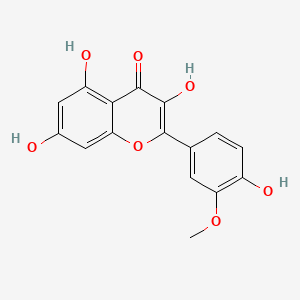| MeSH term | MeSH ID | Detail |
|---|---|---|
| Cystitis | D003556 | 23 associated lipids |
| Breast Neoplasms | D001943 | 24 associated lipids |
| Cataract | D002386 | 34 associated lipids |
| Parkinson Disease | D010300 | 53 associated lipids |
| Hypertension | D006973 | 115 associated lipids |
| Inflammation | D007249 | 119 associated lipids |
| Cell Transformation, Neoplastic | D002471 | 126 associated lipids |
| Hemolysis | D006461 | 131 associated lipids |
| Edema | D004487 | 152 associated lipids |
| Body Weight | D001835 | 333 associated lipids |
Isorhamnetin
Isorhamnetin is a lipid of Polyketides (PK) class. Isorhamnetin is associated with abnormalities such as Facial Hemiatrophy, Colitis, endothelial dysfunction, Morphologically altered structure and Diabetes. The involved functions are known as enzyme activity, Methylation, Anabolism, Binding (Molecular Function) and Vmax. Isorhamnetin often locates in Body tissue, Cytoplasmic, Mucous Membrane, Cytoplasm and Human tissue. The associated genes with Isorhamnetin are CSK gene, RPS6KA3 gene, Mitogen-activated protein, NCF1 gene and Chromatin. The related lipids are Fatty Acids, Phosphatidylserines and Palmitates. The related experimental models are Mouse Model, Xenograft Model and Streptozotocin Diabetes.
Cross Reference
Introduction
To understand associated biological information of Isorhamnetin, we collected biological information of abnormalities, associated pathways, cellular/molecular locations, biological functions, related genes/proteins, lipids and common seen animal/experimental models with organized paragraphs from literatures.
What diseases are associated with Isorhamnetin?
Isorhamnetin is suspected in Colitis, endothelial dysfunction, Morphologically altered structure, Facial Hemiatrophy, Diabetes, Hemorrhagic diarrhea and other diseases in descending order of the highest number of associated sentences.
Related references are mostly published in these journals:
| Disease | Cross reference | Weighted score | Related literature |
|---|
Possible diseases from mapped MeSH terms on references
We collected disease MeSH terms mapped to the references associated with Isorhamnetin
PubChem Associated disorders and diseases
What pathways are associated with Isorhamnetin
There are no associated biomedical information in the current reference collection.
PubChem Biomolecular Interactions and Pathways
Link to PubChem Biomolecular Interactions and PathwaysWhat cellular locations are associated with Isorhamnetin?
Visualization in cellular structure
Associated locations are in red color. Not associated locations are in black.
Related references are published most in these journals:
| Location | Cross reference | Weighted score | Related literatures |
|---|
What functions are associated with Isorhamnetin?
Related references are published most in these journals:
| Function | Cross reference | Weighted score | Related literatures |
|---|
What lipids are associated with Isorhamnetin?
Related references are published most in these journals:
| Lipid concept | Cross reference | Weighted score | Related literatures |
|---|
What genes are associated with Isorhamnetin?
Related references are published most in these journals:
| Gene | Cross reference | Weighted score | Related literatures |
|---|
What common seen animal models are associated with Isorhamnetin?
Mouse Model
Mouse Model are used in the study 'Chemopreventive activity of plant flavonoid isorhamnetin in colorectal cancer is mediated by oncogenic Src and β-catenin.' (Saud SM et al., 2013).
Xenograft Model
Xenograft Model are used in the study 'Isorhamnetin inhibits proliferation and invasion and induces apoptosis through the modulation of peroxisome proliferator-activated receptor γ activation pathway in gastric cancer.' (Ramachandran L et al., 2012).
Streptozotocin Diabetes
Streptozotocin Diabetes are used in the study 'Plant flavonol isorhamnetin attenuates chemically induced inflammatory bowel disease via a PXR-dependent pathway.' (Dou W et al., 2014).
Related references are published most in these journals:
| Model | Cross reference | Weighted score | Related literatures |
|---|
NCBI Entrez Crosslinks
All references with Isorhamnetin
Download all related citations| Authors | Title | Published | Journal | PubMed Link |
|---|---|---|---|---|
| Søltoft M et al. | Pressurised liquid extraction of flavonoids in onions. Method development and validation. | 2009 | Talanta | pmid:19782226 |
| Liu R et al. | [Inhibitory effect of isorhamnetin and hesperidin on the oxidation of high-density lipoproteins (HDL) induced by Cu2+]. | 2007 | Sichuan Da Xue Xue Bao Yi Xue Ban | pmid:18095596 |
| Yang CL et al. | [Inhibitory effect of isorhmnetin on telomerase activity of HeLa cells]. | 2004 | Sichuan Da Xue Xue Bao Yi Xue Ban | pmid:15071915 |
| Yang C et al. | [Effect of isorhmnetin on circadian rhythms of DNA synthesis and expression of c-myc gene in Eca-109 cells of human oesophageal cancer]. | 2005 | Sheng Wu Yi Xue Gong Cheng Xue Za Zhi | pmid:16422106 |
| Chen X et al. | [Applications of two-dimensional liquid chromatography coupled to mass spectrometry for the separation and identification of compounds in ginkgo biloba extracts]. | 2005 | Se Pu | pmid:15881366 |
| Otles S and Yalcin B | Phenolic compounds analysis of root, stalk, and leaves of nettle. | 2012 | ScientificWorldJournal | pmid:22593694 |
| Zhang Y et al. | Dietary component isorhamnetin is a PPARγ antagonist and ameliorates metabolic disorders induced by diet or leptin deficiency. | 2016 | Sci Rep | pmid:26775807 |
| Ritter J et al. | Effect of the antioxidant (+)-cyanidanol-3 on H2O2 formation and lipid peroxidation in liver microsomes. | 1985 | Res. Commun. Chem. Pathol. Pharmacol. | pmid:3983470 |
| Lan K et al. | Quantitative determination of isorhamnetin, quercetin and kaempferol in rat plasma by liquid chromatography with electrospray ionization tandem mass spectrometry and its application to the pharmacokinetic study of isorhamnetin. | 2007 | Rapid Commun. Mass Spectrom. | pmid:17154349 |
| Schmidt S et al. | Identification of complex, naturally occurring flavonoid glycosides in kale (Brassica oleracea var. sabellica) by high-performance liquid chromatography diode-array detection/electrospray ionization multi-stage mass spectrometry. | 2010 | Rapid Commun. Mass Spectrom. | pmid:20552580 |
